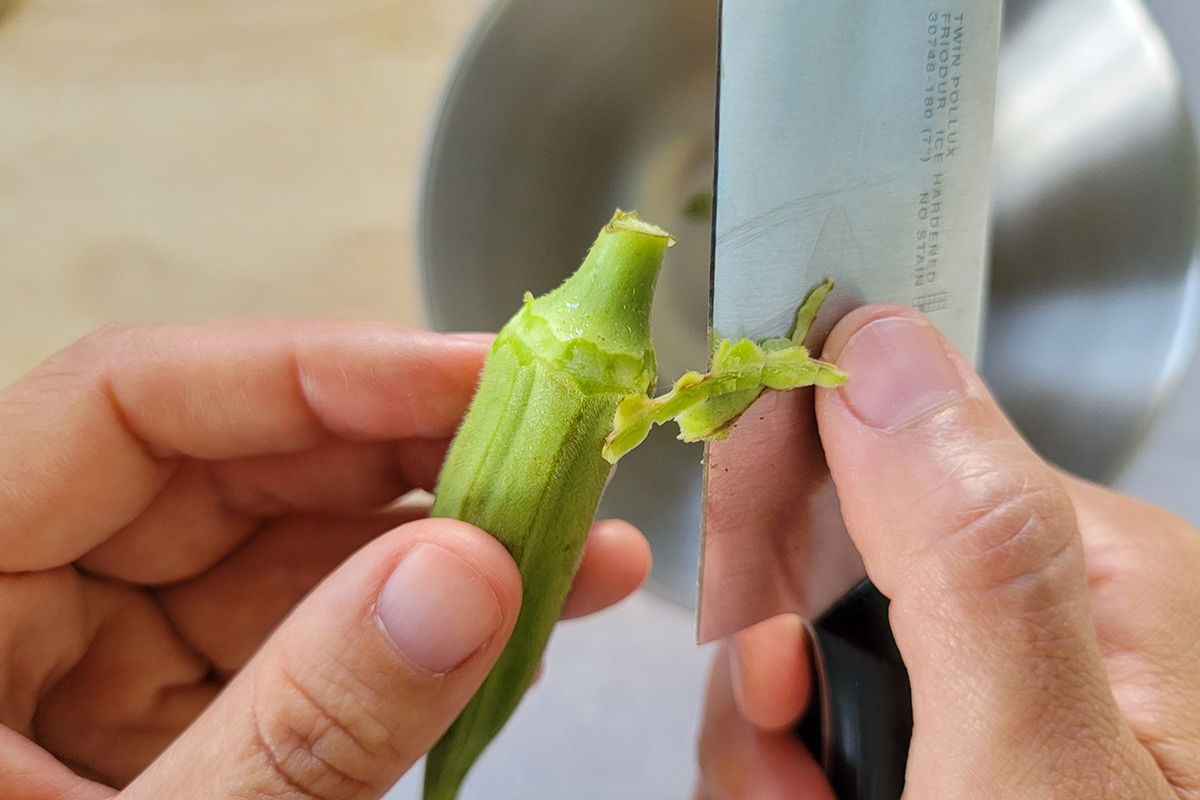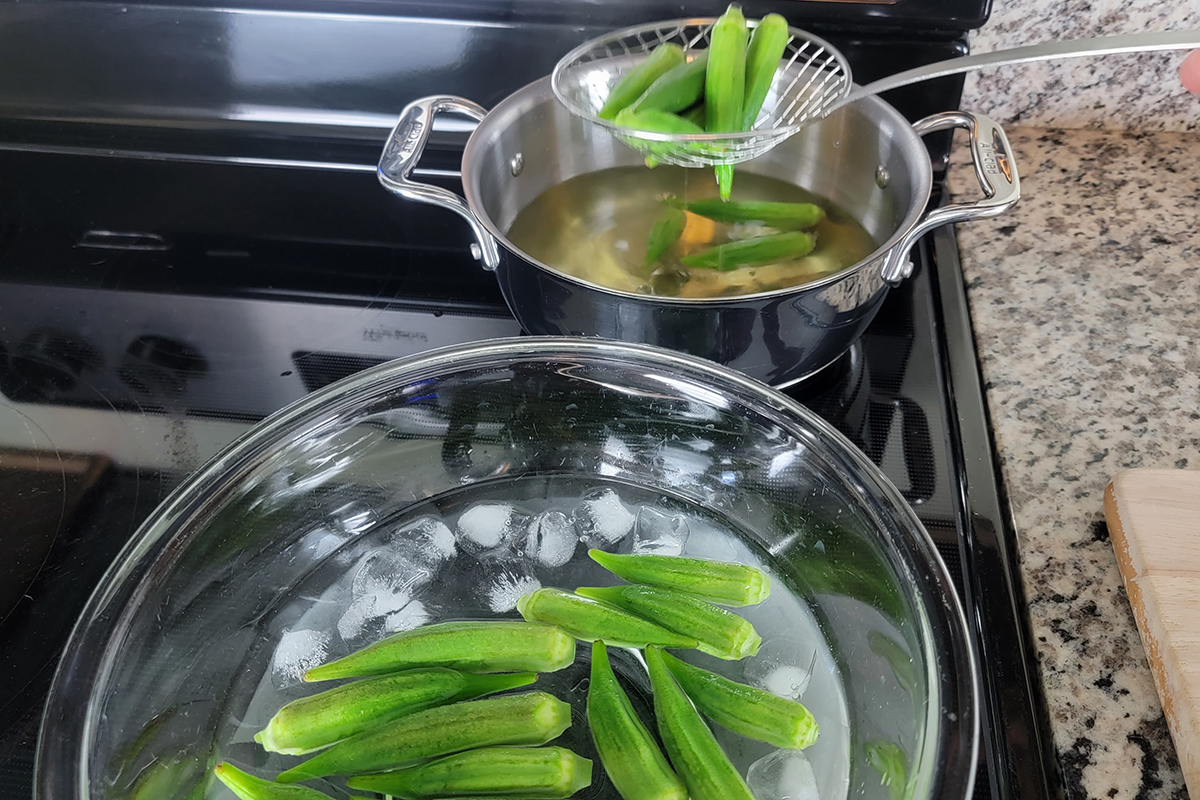Last Updated on September 2, 2022
[和風オクラの和え物(ヴィーガン)]
Japanese Style Seasoned Okra (Vegan) is a simple & light vegan Japanese side dish which is a perfect accompaniment for a bowl of Japanese rice. This dish can be served either at a room temperature or chilled. It can also be prepared gluten free if you replace soy sauce with tamari.
What’s Japanese Style Seasoned Okra
Japanese style Seasoned Okra is a simple, easy, might be a new way to experience a different kind of Japanese side dishes than you may have already been familiar with.
Whether it’s a main or side dish, the traditional Japanese foods are typically made with seasonal ingredients. To present the seasonal ingredient in the most natural state as possible, it’s prepared in the simplest method with minimal ingredients. In other words, it’s never overly salty, too sweet, nor drenched in a heavily seasoned sauce (dressing.)
While this Japanese Style Seasoned Okra is not a chef-prepared traditional dish but made in a very similar way — light and simple.
To be specific, this okra dish is an “aemono [和え物]” style dish. Aemono is a Japanese culinary word which means “lightly seasoned or dressed things.” Thus this dish was named, Japanese Style Seasoned Okra.
Aemono can be as simple as dressing something only with soy sauce or a combination of a few basic seasonings such as soy sauce, miso, rice vinegar, salt, sugar, and/or sesame seeds etc.
Okra
Okra is an edible green pod with white seeds in it. When you slice it, it has a pretty star-shaped cut side and you may see and feel the characteristic texture, the sliminess.
For a long time, I thought okra was a vegetable originated in Japan. LOL. The word okra, for some reason, sounds like a Japanese word (at least to me) and I grew up eating a lot of it. Most Japanese people enjoy slimy textured food such as natto, nagaimo (Japanese mountain yam), mozuku seaweed, nameko mushrooms and okra.
Okra is one of those produce that either you like it or you just dislike it because of the slightly slimy texture. Since it was always a part of my diet ever since I was a child, I don’t find it strange but my husband didn’t like it at first.
Despite of the sliminess, the taste is very mild. It’s definitely has an acquired texture but once you know how to prepare it, you’ll start appreciate the taste.
As my mom would always say, slimy food is really good for your gut health. It picks up the impurities from your gut and moves it down and eventually out of the body.
Taste
My Japanese Style Seasoned Okra is basically blanched and seasoned.
I use the ingredients below:
- Soy Sauce
- Toasted Sesame Oil
- Sea Salt
- Cane Sugar
- White Pepper
- Toasted Sesame Seeds
I’m sure most people already have them in there pantry so it’s easy to prepare. It has different types of flavors from all the ingredients yet nothing is really overpowering or heavily seasoned. Again, this is a really lightly seasoned dish as how the typical Japanese people would eat.
When you make a simple dish like this Japanese Style Seasoned Okra, a few cooking tips may make a big difference in the overall taste and the presentation. So, here are some of my tips!
How to Serve
I’d suggest to enjoy Japanese Style Seasoned Okra with a bowl of Japanese white rice. In fact, most Japanese side dishes are made to eat with rice. It’s the way the Japanese people eat! Or, serve this as an appetizer to a main coarse of your choice.
For the serving temperature, it can be at a room temperature or chilled. Leftover is also delicious as the flavor settles in the fridge!
Cooking Tips for Japanese Style Seasoned Okra
For more information, please print out and refer to the recipe. Also, you can check out the step-by-step instructions with photos at the end of the post which will guide you through the whole process!
Size of Okra
I find okra grown here in the US are so much larger than the ones I used to eat in Japan. I feel that because of the size difference, okra in Japan is a lot tenderer than the ones in the US. In other words, okra here can be slightly tougher and fiber-y (stringy.) Sometimes, when you slice the okra, it feels like cutting a radish or a potato which gives a little resistance, then you’ll know it’s too fiber-y to consume.
While those ones are edible, it’s not the best choice for this recipe. In your best interest, I’d recommend you to find small to medium size okra.
Too Slimy?
Slimy texture is one of the characteristics of okra and it’s something that you can’t get rid of it. But, there are ways to make it somewhat less noticeable.
For example, when you make this particular recipe;
- Handle okra gently when rinsing, cooking, cutting etc.
- Keep the exposure of cut-opened sides to minimum.
- Cook in the hot water for the recommended time according to the recipe instructions (not longer than that.)
- Don’t let them soak in the ice bath (or any liquid in general) for too long.
Just a little mindful actions during the cooking process would reduce the slimy effect at the end result.
Okra Hair
Have you noticed okra has hair? It’s super thin, short and in many cases tender enough so it wouldn’t bother you when you eat them. In fact, chances are you’ve never even tried to remove it. But, in Japanese cooking, we do an extra step to remove some of the hair and to tenderize the prickly one when making a okra dish.
The method is called “itazuri [板ずり]” in Japanese.
The direct translation of itazuri can be “rubbing on a board.” Basically, what you do is to place okra on a cutting board and sprinkle some salt on them. Then, gently roll them back and forth. With this method, you can remove some hair (it won’t completely come off) also tenderize some rough edges of the hair that may be unpleasant to eat.
As a result of the itazuri process, the surface of okra will become smoother. Also, the salt would help to retain the bright green color when cooked.
Is this step 100 % necessary? May be not. But it makes the dish a little more sophisticated. Moreover, it’s fun to learn a new cooking technique, isn’t it?
Toasted Sesame Seeds
I use toasted sesame seeds in this okra recipe. But what I do is to grind them instead of using them as whole. Grinding is optional however I’d recommend doing so if possible.
Ground toasted sesame seeds are called “surigoma [すりごま].” “Suri (or suru)” means “to grind” and “goma” means sesame seeds. As the name says it all, you simply grind toasted sesame seeds using a Japanese mortar and pestle called “suribachi and surikogi [すり鉢とすりこぎ].” Suribachi has fine ridges inside which help grind process easily and finely.
Grinding toasted sesame seeds is another common cooking method in Japanese cuisine especially for the “aemono” that’s been mentioned earlier. Compare to using them as whole, ground toasted sesame seeds releases more taste and aroma, also it blends in better (evenly distributed) in the dressing (sauce.)
You don’t have to buy the Japanese mortar and pestle just to make this recipe. In fact, you could do a similar job with a western mortar and pestle. Otherwise, leave the sesame seeds as whole. They are still just as delicious!
Be sure to check out the “Step-by-Step Instructions (w/ Photos)” after the Printable Recipe!
Japanese Style Seasoned Okra (Vegan)
Ingredients
Dressing
- 2 tsp soy sauce or tamari for GF
- 1 tsp toasted sesame oil
- 1/4 tsp sea salt
- 1/4 tsp cane sugar
- 1/8 tsp or less white pepper
- 1 tsp toasted sesame seeds preferably partially ground
Preparing Okra
- 7 oz small to medium size okra
- 1/2 - 3/4 tsp sea salt to massage okra
Cooking Okra
- 3 cups water
- 2 tsp sea salt
Instructions
- First, prepare the dressing. In a medium to large prep bowl, combine soy sauce, toasted sesame oil, sea salt, sugar, white pepper and toasted sesame seeds (ground or whole.) Use a whisk to mix well and set it aside.
- In a small sauce pan, start boiling water for cooking okra.
- Meanwhile, prepare okra. Place the okra in a colander and gently rinse under running water. Use a clean kitchen towel (paper towel) to gently pat to dry them. Next, use a knife to peel off the brown edge around the head of a okra then trim off the very tip (head side) of it. Repeat the process.Note: This step is highly recommended for a better texture however if you don’t feel comfortable with your knife skill, skip the peeling process and just trim off the very tip of okra (head side.)
- After peeling and trimming, place 5-6 pieces of okra on a cutting board. Sprinkle about 1/8 tsp sea salt over the okra. Use your hand to roll them gently back and forth to massage and set them aside (leave the salt on.) Repeat the process. This step is to remove some of the hair and to get rid of prickly hair on the surface of okra. There will be hair remained on the okra but this is completely normal.Tips: Use about 1/8 tsp per 5-6 pieces of okra --- 1/2 to 3/4 tsp total.)
- Once all the okras are massaged, prepare an ice bath then start cooking. Add 2 tsp sea salt to the boiling water then add the okra and cook for 60-90 seconds (up to 2 minutes.) Once okra is at your desired texture, transfer to the ice bath to shock them.Tips: Cooking for 60 seconds will result for a crispy bite, 90 seconds for a little tenderer texture, and 2 minutes for very tender.
- Remove the okra from the ice bath and drain well. Use a clean kitchen towel (paper towel) to gently pat to remove the excess water.
- Slice the okra in half or third diagonally depending on the size.Tips: Less cut-open surface of okra will result less slimy texture in the end.
- Transfer to the bowl with the dressing made in step 1. Toss and dress with the dressing gently. Adjust the seasoning with a pinch of salt if necessary.
- Serve at a room temperature or chilled with a bowl of rice or as an appetizer.
Notes
Choosing a Right Size of Okra
- It’s best to use small to medium size okra which are tender. Large size okra tends to be stringy and tough.
Sliminess of Okra
- Okra is naturally slimy especially the inside (the seeds) is exposed.
- To make it less slimy for this recipe;
- Handle them gently when rinsing, cooking, cutting etc.
- Keep the exposure of cut-opened sides to minimum.
- Cook in the hot water for the recommended time according to the recipe instructions (not longer than that.)
- Don’t let them soak in the ice bath (or any liquid in general) for too long.
Ground Toasted Sesame Seeds
- In Japanese cooking, ground toasted sesame seeds are used often especially in a simple seasoned dishes like this recipe.
- Ground toasted sesame seeds blend better in a dressing and releases more flavor and the aroma.
- Grinding toasted sesame seeds is preferred (optional) however, you can use them as whole to keep it simple and easy.
- You can grind toasted sesame seeds using a Western mortar and pestle or preferably the Japanese mortar and pestle called “suribachi and surikogi” for easier grinding.
How to Serve
- It’s best to serve as a side dish with a bowl of Japanese rice.
- You can serve either at a room temperature or chilled in the fridge
How to Store
- You can save any leftover in an airtight container, keep in the fridge and consume within 2-3 days.
Step-by-Step Instructions (w/ Photos)
Optional Preparation Step:
If using ground toasted sesame seeds, place the sesame in a Japanese mortar and pestle. Gently grind them until 70 % ground then set it aside.
1. First, prepare the dressing.
In a medium to large prep bowl, combine soy sauce, toasted sesame oil, sea salt, sugar, white pepper and toasted sesame seeds (ground or whole.)
Use a whisk to mix well and set it aside.
2. In a small sauce pan, start boiling water for cooking okra.
3. Meanwhile, prepare okra.
Place the okra in a colander and gently rinse under running water.
Use a clean kitchen towel (paper towel) to gently pat to dry them.
Next, use a knife to peel off the brown edge around the head of a okra then trim off the very tip (head side) of it. Repeat the process. Note: This step is highly recommended for a better texture however if you don’t feel comfortable with your knife skill, skip the peeling process and just trim off the very tip of okra (head side.)
4. After peeling and trimming, place 5-6 pieces of okra on a cutting board. Sprinkle about 1/8 tsp sea salt over the okra.
Use your hand to roll them gently back and forth to massage and set them aside (leave the salt on.) Repeat the process. This step is to remove some of the hair and to get rid of prickly hair on the surface of okra. There will be hair remained on the okra but this is completely normal. Tips: Use about 1/8 tsp per 5-6 pieces of okra — 1/2 to 3/4 tsp total.)
5. Now, cooking the okra.
Once all the okras are massaged, prepare an ice bath then start cooking.
Add 2 tsp sea salt to the boiling water then add the okra and cook for 60-90 seconds (up to 2 minutes.) Once okra is at your desired texture, transfer to the ice bath to shock them. Tips: Cooking for 60 seconds will result for a crispy bite, 90 seconds for a little tenderer texture, and 2 minutes for very tender.
6. Remove the okra from the ice bath and drain well.
Use a clean kitchen towel (paper towel) to gently pat to remove the excess water.
7. Slice the okra in half or third diagonally depending on the size. Tips: Less cut-open surface of okra will result less slimy texture in the end.
8. Transfer to the bowl with the dressing made in step 1.
Toss and dress with the dressing gently. Adjust the seasoning with a pinch of salt if necessary.
9. Serve at a room temperature or chilled with a bowl of rice or as an appetizer.
If you enjoy the recipe, please share, leave a comment below and tag us @plantbased_matters on Instagram! We appreciate your kind support 🙂















































Absolutely delicious! Even the picky eaters in my family helped themselves with a second serving. Definitely earned a place in my cooking repertoire. Thank you for sharing this recipe. And also for informing us about Japanese pestle and mortar, I want to try making one in a kiln when I have the chance.
Hi Sevim,
Thank you so much for your kind words! I’m thrilled to hear that the picky eaters enjoyed it enough to go back for seconds—that truly makes my day. It means a lot to me that you’ve added this recipe to your recipe repertoire!
Please keep us posted on how it turns out in the kiln. I’m excited to hear the results!
Kind regards,
Akiko